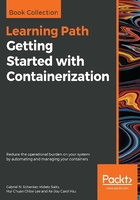
Network firewalling
Docker has always had the mantra of security first. This philosophy had a direct influence on how networking in a single and multihost Docker environment was designed and implemented. Software-defined networks are easy and cheap to create, yet they perfectly firewall containers that are attached to this network from other non-attached containers, and from the outside world. All containers that belong to the same network can freely communicate with each other, while others have no means to do so:

In the preceding image, we have two networks called front and back. Attached to the front network, we have containers c1 and c2, and attached to the back network, we have containers c3 and c4. c1 and c2 can freely communicate with each other, as can c3 and c4. But c1 and c2 have no way to communicate with either c3 or c4, and vice versa.
Now what about the situation where we have an application consisting of three services, webAPI, productCatalog, and database? We want webAPI to be able to communicate with productCatalog, but not with the database, and we want productCatalog to be able to communicate with the database service. We can solve this situation by placing webAPI and the database on different networks and attach productCatalog to both of these networks, as shown in the following image:

Since creating SDNs is cheap, and each network provides added security by isolating resources from unauthorized access, it is highly recommended that you design and run applications so that they use multiple networks and run only services on the same network that absolutely need to communicate with each other. In the preceding example, there is absolutely no need for the web API component to ever communicate directly with the database service, so we have put them on different networks. If the worst-case scenario happens and a hacker compromises the web API, they have no ability to access the database from there without first also hacking the product catalog service.